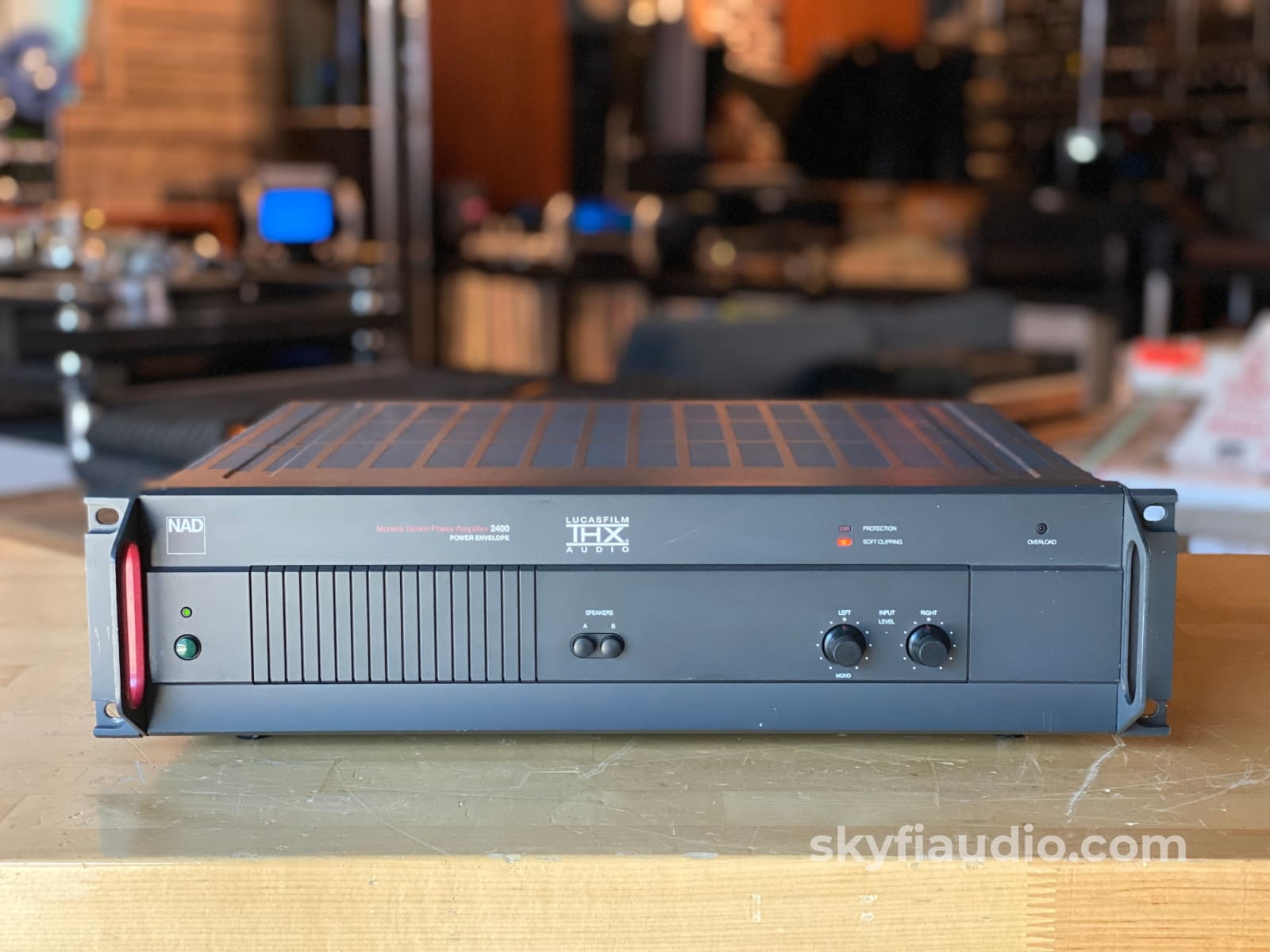









NAD 2400 Monitor Series Amplifier - THX Rated
Free Shipping on Most Electronics - Excludes Speakers and Items Requiring Freight - Contiguous U.S. Only
Pickup currently unavailable at SkyFi 479

NAD 2400 Monitor Series Amplifier - THX Rated
SkyFi 479
479 South Broad Street
Glen Rock NJ 07452
United States
General:
Great vintage amplifier from NAD's golden era, the monitor series was top of the line at the time.
This particular amp was in my personal collection for decades and was also used in my test bench along with the matching preamp.
Notice the official NAD rack handles are in place, which can fetch several hundred dollars alone and are super rare.
This amp is working brilliantly and is super robust.
Rated at 100W which is enough to drive most speakers. Also has a THX rating guaranteeing its output capabilities.
Cosmetic Notes:
• Scuffs and scratches throughout
ª One rack handle is missing its red rubber insert
More from NAD:
The 2400 has the same features and useful flexibility as the 2100, but produces significantly higher levels of real speaker-driving power.
With continuous test tones its output is conservatively rated at 100 watts per channel, while its Power Envelope circuitry produces 370 to 440 watts channel of tone-burst power for music.
The high-current output stage of the 2400 delivers peak currents up to 40 amperes for precise control of voice-coil motion with speaker impedances as low as 2 ohms.
In bridged mono operation the 2400 produces over 200 watts of steady-state power and over 800 watts of dynamic tone-burst power.
To enable the user to make the fullest use of the available power, a warning light illuminates if the amplifier is over-driven into distortion or exhibits any deviation from linearity. A high-precision circuit continually compares the input and output signals and flashes the LED if a potentially audible difference is detected.
Each stage of the amplifier (input, driver, and output) is individually decoupled from the power supply to prevent the dynamic supply-modulation distortion that causes some amplifiers to sound "veiled" and muddy.
Ownership:
Second Owner
Connections:
RCA Inputs and passthrough, captive power cord, convenience outlets, speaker terminals accepting banana, bare wire and spades
General Sound:
Smooth, uncolored, undistorted natural and clean
Cosmetic Condition:
6/10 = Fair. Three to four minor scratches, or one major scratch. See our detailed rating description here.
Working Condition:
Working perfectly and tested in our lab and listening room.
Included:
Just the unit and power cord.
Manual:
Click Here
Packing:
Will be packed using our highly developed in-house process and custom packing materials.Specs:
Power output:
100 watts per channel into 8Ω (stereo)
300 watts into 8Ω (mono)
Frequency response:
20Hz to 20kHz
Total harmonic distortion:
0.03%
Damping factor:
100
Gain:
29 dB
Input sensitivity:
1V
Signal to noise ratio:
98dB
Speaker load impedance:
4Ω (minimum)
Dimensions:
17.13" x 4.72" x 14.96" (435 x 120 x 380mm)
Weight:
22.05 lbs. (10kg)
Approximate Age:
1989
Recommended Cables:
Kimber Kable - RCA Interconnects - Better
Kimber Kable - Speaker Cables - Better
The SkyFi Testing Process for Solid State Amplifiers:
We start with a visual inspection of all internal components to make sure that there are no signs of heat stress or damage. Capacitors are checked for telltale signs of predictive failure including bulging, shrunken wrappers, or physical leakage. We also inspect the PCBs for discoloration from resistors or transistors that may have been running hot. On vintage units we often spot check select capacitors for value and ESR.
If the amplifier passes visual inspection, we move on to a controlled power on sequence using a Sencore safety analyzer to monitor current draw in real time. Once the amplifier is determined to be safe to operate, we connect it to full AC mains for function and power testing. We connect the speaker outputs of the amplifier to a Sencore PA81 Power Analyzer which acts as a dummy load, DC offset monitor, and oscilloscope interface. We start with a low level 1KHz test signal at the amplifier’s input and slowly increase its amplitude while monitoring the output on an oscilloscope for signs of noise, clipping, distortion, or improper channel balance. We continue increasing the signal level until the amplifier reaches clipping. At this point we take an output power measurement and compare it to the spec sheet of the amplifier to verify proper performance. If the device under test has both balanced and single ended inputs they are both tested at this time. We finish off the bench evaluation with a 1KHz square wave check and a 20Hz to 20KHz sine sweep to assess the amplifier’s frequency response characteristics. This battery of tests will usually reveal if the amplifier has any issues that need further attention.
Before the device leaves the bench, we perform a listening test with actual music using a variety of preferred test tracks. Our benches are outfitted with familiar monitor speakers which help us identify inconsistencies that will not always show up on our test gear. The main things that we are listening for are hum or noise with no signal present, proper center image, clicks, pops, or any other obvious undesirable audio characteristics.
If the unit passes all of these tests it is moved to our long term testing rig where we simulate real word operating conditions for 6-8 hours. This allows us to monitor the unit for signs of thermal runaway or intermittent issues that only crop up when the unit has fully come up to temperature.
Choose options










